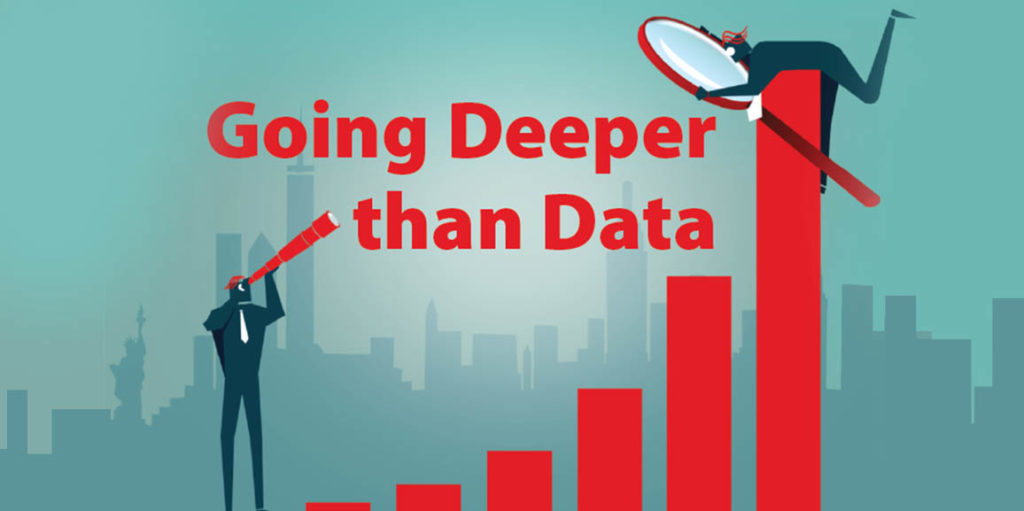Going Deeper Than Data

By Lorrie Bryan
“Businesses don’t have relationships with businesses – people have relationships with people.”
– Dimitri Kapelianis, Associate Marketing Professor, University of New Mexico
But you can click-click-click until your fingers ache; search the expansive internet heavens; gaze intently into your super-duper, 32-inch, professional-grade, ultra-high-definition monitor; crank up the latest Voice of the Customer program; dive into social media; and still not understand your customers sufficiently.
If you really want to know what keeps your best customers up at night, what’s on their wish lists, and what you can do to help their businesses succeed and their dreams come true, try an old-fashioned, pre-information-age practice. It’s called conversing, personal interaction and visiting – and it can make a deep impact.
Vis-à-vis visits
As Dimitri Kapelianis, an associate marketing professor at the University of New Mexico, points out, B2B marketing almost is a misnomer. “Businesses don’t have relationships with businesses – people have relationships with people. If your product is not a commodity, you need to have dedicated account managers working with your best customers, actively nurturing the relationships, looking for unique opportunities to create value and making certain that these customers are exceedingly satisfied.”

Kapelianis says that it’s not enough to know your industry and your company. You must know the key people personally and visit with them on a regular basis. You must be able to anticipate their problems and offer unique solutions. Be proactive, rather than reactive.
If all you are doing is waiting for an invitation to bid, it’s almost too late. “You’re then just a commodity, and if that is the case, then you better have the lowest price,” says Kapelianis, who teaches graduate-level marketing strategy classes.
But building an authentic relationship takes time, and disingenuous schmoozing actually can hamper the process. Increasingly, Gen Xers are moving into decision-making roles, and they are especially skeptical of marketing speak. They prefer a more direct approach to communication.
“Gen Xers don’t like canned, overly packaged corporate messaging and appreciate the facts relative to the bottom line,” says Anna Liotta, author of “Unlocking Generational Codes.” “Provide them with information to do their own research and product comparisons. Don’t waste time schmoozing and trying to develop a relationship initially. Be direct and cut to the chase – show them where the value lies.”
“Nobody is going to buy from you solely because they like you,” Kapelianis says. “You have to demonstrate how you can add value.”
Board games
Many companies are finding that developing a Customer Advisory Board (CAB) program is a great way to foster relationships and make an impact with top customers. A CAB also can yield tremendous insights for both the host company and the participating customers. Sometimes referred to as an executive advisory council, customer summit or best customer panel, a CAB essentially is a strategy-level focus group.
“It’s an opportunity for a CEO and executive staff to meet with a dozen key leaders and decision makers representing some of their best customers to talk about trends and drivers shaping their customers’ businesses, and how the host company can help these customers achieve their business goals,” says Mike Gospe, who has facilitated and assisted more than 100 businesses with CABs since 2002. “There are many names for a Customer Advisory Board, but they all share the same objective – to forge a tighter bond with a set of strategic customers and invite them to help shape your company’s vision and strategic direction.”
Limited to primarily Fortune 500 companies a decade ago, CABs have grown in popularity in recent years. “Now, large and smaller B2B companies are investing in a CAB program,” says Gospe, founder of KickStart Alliance, a team of senior marketing and sales consultants.
And here’s the best part. A CAB is not just a marketing tool or special marketing project. “The implications of what is learned will need to cascade through marketing, sales, operations, engineering, customer support, etc.,” Gospe says. “A commitment to a CAB must be companywide, ongoing and linked directly to a company’s annual planning process.”
San-gen-shugi: The Three Realities Principal
Building deep relationships with key customers is inherently a companywide endeavor for many successful companies. David Stevens, senior VP of American Mitsuba Corp., says that Mitsuba builds authentic customer relationships and loyalty by practicing ancient Japanese business principles that promote direct observation and contact.
“When a customer requests anything, we take it seriously,” Stevens says. “Usually we meet face to face with the customer for any significant request. We frequently have customers visit us in our plants, so they can better understand what makes us tick and see how good we are.”
Mitsuba and other Japanese-American companies (Toshiba, Takata, Honda) practice San-gen-shugi in many elements of their business management. “San” means three, “gen” means what you actually see in front of you and “shugi” means principles.
Stevens says that San-Gen-Shugi has three elements. This means you go to the actual site (genba), see the actual thing or condition (genbutsu) with your own eyes, to understand and respond to the actual situation (genjitsu).”
This is the most valid method to conduct situation analysis and respond appropriately, instead of depending on reports and comments from other people. “We go directly to our customers and see their actual situation and needs first hand,” Stevens says. “Then we can propose changes and solutions that more than satisfy them.”
Eye to eye, heart to heart
Eye contact has a fundamental role in human social interaction. When you make eye contact while conversing, heartbeat rates actually increase revealing a physiological connection between you and the person you’re having a conversation with.
Want more?
Subscribe to Connect today.
Coming soon to your mailboxes and doorsteps!

